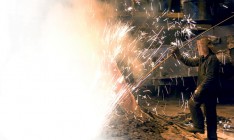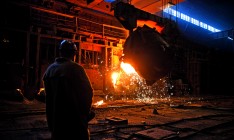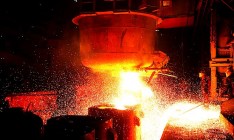Business
metallurgy industryArcelorMittal Kryviy Rih reports a sales record of semi-finished metallurgy products
In May Ukraine’s most powerful steel mill Arcelor-Mittal Kryviy Rih (AMKR) significantly increased its output of iron ore by 22%, steel by 22.2% and rolled steel by 16% compared to April 2014.
Moreover, the steel mill did not show such monthly indicators since the beginning of the crisis. “Industrial output of the enterprise in May 2014 was the most impressive since September 2008 with a record-high level of output of iron ore, steel and rolled steel,” said Chief Operating Officer of the steelworks Paramjit Kahlon.
By the way, market analysts did not see anything unusual in this blip. “At the beginning of the year the company significantly curtailed production upon the decision to renovate some of their production facilities. In January, the output of iron ore fell by 30% y-o-y. After the renovation has been completed the plant is renewing its output volumes,” said Roman Topoliuk, analyst at Concorde Capital. As a result, despite the record-high output results in May, in the first five months of 2014 the plant did not achieve the results of the same period of the previous year with respect to all types of products. For example, the output of rolled steel in 2014 was 2.18 mn t compared to 2.28 mn t in 2013 and the output of steel in 2014 was 2.48 mn t compared to 2.59 in 2013.
How to explain growth
At the moment, a significant demand for metallurgical products made in Ukraine that could be considered a reason for an increase in output at AMKR has not been observed. Nevertheless, Director of the State Enterprise Ukr-Prom-Vnesh-Ekspertyza Pavlo Perkonos noted that the steel mill could have shifted to the sale of semi-finished products. “The demand for semi-finished products on the still weak market of metal products remains high. Clearly, ArcelorMittal Kryviy Rih took advantage of this opportunity by increasing its contracts for the shipping of billets to Turkey and North America,” the expert assumes.
Topoliuk shares the same opinion as his colleague. In 2014 the share of billets in the production structure of AMKR was 31-37%, which is considerably higher compared to the 25% in 2012-2013, he observes. “This points to the negative conditions on the market that make it more difficult to sell finished products indicating that competition will become more fierce,” says the expert, explaining the market dynamics. According to his figures, the share of rolled wire in the output of the steel mill is approximately 18% today compared to 14% at the beginning of the year. “The price of rolled wire has remained higher than the price of re-bar since February. The difference is USD 10-20 per metric ton,” said Topoliuk. According to his assessments, it is currently more profitable for the producer to roll the rolled steel into rolled wire instead of re-bar, which was condition behind the renewal of the share of rolled wire in the total volume of production.
In June the price of rolled wire produced by AMKR grew to USD 553/t from USD 527/t in May. The price of re-bar last month fell from USD 540/t to USD 527/t. In May the price of rolled wire also increased compared to April, when the price was not higher than USD 506/t on average.
So, at the moment AMKR is orienting its business towards the output of billets and rolled wire and reducing the output of re-bar, the expert says.
Who remains on the upside?
The price of another semi-finished product – slab – increased from USD 480/t in April to USD 490-505/t in May (FOB, Black Sea), says Perkonos.
This was due to the long-awaited market recovery in the EU on the backdrop of the revival of demand of steel consumers in regions. AMKR does not produce slab, but those steel mills that produce slab and billets immediately took the bait. In particular, according to the results of five months when AMKR reduced its output by 4.3% compared to the previous year (and the entire metallurgy industry – by 6.7%), Perkonos said the Yenakiyevo Steel Mill increased its output by 11% and Zaporizhstal by 4%. Both of these enterprises are part of MetInvest controlled by Rinat Akhmetov. Also, the Industrial Donbas Union controls 6.6% in the Alchevsk Metallurgy Plant. The products of both these steel mills were in high demand mainly in Italy, Hungary and Poland.
China penetrating global steel market
At the moment, a gradual seasonal decline in demand on global markets is being observed, which will restrain the possible rise in prices at least over the next several weeks. Besides that, the low price of iron ore on the spot market in China remains a weighty factor of influence on the metal prices.
Metallurgy plants will see the revival of demand and a rise in prices in July, Perkonos believes. Nevertheless, the market, as earlier, will not see the global demand recovery in the nearest future, analysts presume. Competition is becoming fiercer in a greater number of market segments. “While earlier metallurgists had to fight for markets with Chinese exporters of finished products, today they are feeling the pressure from China on prices in the segment of semi-finished products,” Perkonos noted.
The output of iron ore by ArcelorMittal Kryviy Rih in May increased by 22% in May, steel – by 22.2% and rolled steel – by nearly 16%.






 of the agreement of syndication with Financial Times Limited are strictly prohibited. Use of materials which refers to France-Presse, Reuters, Interfax-Ukraine, Ukrainian News, UNIAN agencies is strictly prohibited. Materials marked
of the agreement of syndication with Financial Times Limited are strictly prohibited. Use of materials which refers to France-Presse, Reuters, Interfax-Ukraine, Ukrainian News, UNIAN agencies is strictly prohibited. Materials marked  are published as advertisements.
are published as advertisements.